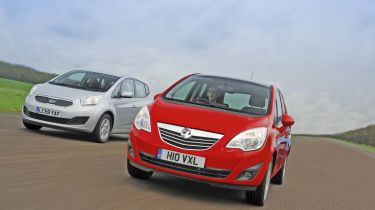Meriva vs. Kia Venga
In first of our tests, new hope goes up against the class-leading supermini-MPV
The Meriva is growing up. Take a tape measure to the latest version of the versatile Vauxhall, and you will see it’s similar in size to models from the class above. It’s nearly 200mm longer and over 100mm wider than before, which has led to an increase in cabin space.
Bosses also promise major strides in build quality and a welcome injection of upmarket appeal. But the Meriva isn’t the only supermini-MPV with big ideas. Kia’s Venga is our current sector champion, thanks to its family car-sized interior and penny-pinching price. It matches the Vauxhall in nearly every interior dimension, so it represents a stern test.
What’s immediately clear is that the Meriva has more visual impact. Taking design cues from the firm’s Insignia and Astra, it appears convincing. At the front are large, swept-back headlamps and a bold chrome grille. Look down the flanks and you can’t miss the kink in the window line.
But it’s the Meriva’s FlexDoors that will spark the most interest from passers-by. The novel rear-hinged suicide back doors are similar to those on the Rolls-Royce Phantom, and open at nearly 90 degrees. When there’s room to take advantage of this, they definitely improve access.
Useful
Used - available now

2019 Ford
Fiesta Vignale
44,100 milesManualPetrol1.0L
Cash £10,500
2022 Volkswagen
ID.3
33,043 milesAutomaticElectric
Cash £13,500
2023 Audi
e-tron
50,934 milesAutomaticElectric
Cash £18,900
2022 Dacia
Duster
49,300 milesManualPetrol1.0L
Cash £11,100Even in narrow spaces they’re useful, because you can get the benefit of the full height of the door opening, rather than trying to squeeze over and around the rear wheelarch. Anyone with small kids in child seats will really notice the difference.
The interior majors on flexibility and, as with its rival, the Meriva has a sliding split rear bench that allows you to optimise legroom or boot space. But the Vauxhall goes one step further. Fold its centre section flat, push the outer seats all the way back and it’s possible to move them inwards by a few millimetres to free up shoulder room.
Elsewhere, there are lots of neat touches designed to make the Meriva family friendly. Running between the front seats is the new FlexRail system. It can be fitted with various storage cubbies and trays, or simply used to accommodate handbags. There are decent-sized door bins front and rear, plus our flagship SE has a standard panoramic glass roof.
The fit and finish are really impressive, too. Soft-touch materials are used throughout, and most of the high-quality switchgear will be familiar to Insignia and Astra drivers.
The handsome dash adds a dose of premium desirability to the Meriva’s cabin, and you can even specify big car options like a heated steering wheel!
It’s all a stark contrast to the Kia’s simple layout. The Venga is logically arranged and features a robust finish with decent plastics. It doesn’t have the high-end feel of the Meriva, but doesn’t come across as a poor relation, either.
And what it lacks in interior polish it makes up for with plenty of equipment. Climate control, an electric glass sunroof and iPod connection all feature as standard in flagship 3 trim – the Vauxhall makes do with basic air-con.
The Kia also offers masses of space. Despite being shorter than the Meriva on the outside, it has a bigger cabin. Five adults will fit comfortably, while the glovebox and door pockets are more generously proportioned.
Open the tailgate and you’ll find a well shaped 440-litre load bay – a useful 40 litres more than in the Vauxhall. And both cars feature a false boot floor, which hides extra storage underneath and provides a flat luggage area when the rear seats are folded.
While the Venga takes the spoils in the space race, it loses out on pace. Its smooth 89bhp 1.4-litre engine can’t match the Meriva’s 118bhp turbo for muscle. At the test track, the Vauxhall covered 0-60mph in 10.5 seconds – an advantage of 1.7 seconds. And while the powerplant is strained at high revs, it delivers stronger mid-range performance, for more relaxed long-distance cruising.
On the open road, the Meriva impresses with its refinement and grown-up driving dynamics. The blend of well weighted steering, strong grip and good body control means plenty of poise in corners, while even rough roads fail to upset the newcomer’s composure.
In contrast, the Kia’s firm suspension highlights bumps and potholes. The payback comes on twisty roads, where the Venga has a more sporty character –
although its electrically assisted steering offers minimal feedback.
The Meriva ticks all the right boxes, with its polished driving dynamics, versatile cabin and clever rear doors. However, it falls down on price. In top SE trim, our 118bhp petrol model is £18,145. The similarly equipped Venga 3 costs £4,050 less, at £14,095, and comes with Kia’s excellent seven-year warranty – so it’s hard to see anything but a Korean victory.
Details
WHY: Kia is on the march, and the Venga is latest in a long line of great-value models from the Korean firm. It’s also roomy and well equipped, making it a strong contender.







